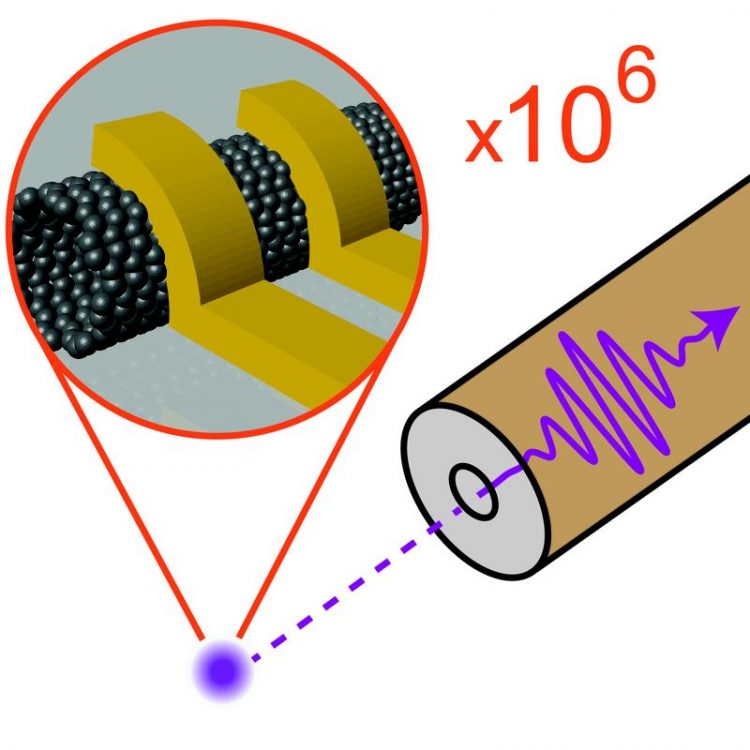Basel Physicists Develop Efficient Method of Signal Transmission from Nanocomponents

The clever arrangement of two electrical conductors around the carbon nanotube leads to an efficient signal transmission between the nanotube and a much larger conductor. University of Basel, Department of Physics/Swiss Nanoscience Institute
Electronic components are becoming smaller and smaller. Components measuring just a few nanometers – the size of around ten atoms – are already being produced in research laboratories. Thanks to miniaturization, numerous electronic components can be placed in restricted spaces, which will boost the performance of electronics even further in the future.
Teams of scientists around the world are investigating how to produce such nanocomponents with the aid of carbon nanotubes. These tubes have unique properties – they offer excellent heat conduction, can withstand strong currents, and are suitable for use as conductors or semiconductors.
However, signal transmission between a carbon nanotube and a significantly larger electrical conductor remains problematic as large portions of the electrical signal are lost due to the reflection of part of the signal.
Antireflex increases efficiency
A similar problem occurs with light sources inside a glass object. A large amount of light is reflected by the walls, which means that only a small proportion reaches the outside. This can be countered by using an antireflex coating on the walls.
Led by Professor Christian Schönenberger, scientists in Basel are now taking a similar approach to nanoelectronics. They have developed an antireflex device for electrical signals to reduce the reflection that occurs during transmission from nanocomponents to larger circuits. To do so, they created a special formation of electrical conductors of a certain length, which are coupled with a carbon nanotube. The researchers were therefore able to efficiently uncouple a high-frequency signal from the nanocomponent.
Differences in impedance cause the problem
Coupling nanostructures with significantly larger conductors proved difficult because they have very different impedances. The greater the difference in impedance between two conducting structures, the greater the loss during transmission. The difference between nanocomponents and macroscopic conductors is so great that no signal will be transmitted unless countermeasures are taken. The antireflex device minimizes this effect and adjusts the impedances, leading to efficient coupling. This brings the scientists significantly closer to their goal of using nanocomponents to transmit signals in electronic parts.
Original source
V. Ranjan, G. Puebla-Hellmann, M. Jung, T. Hasler, A. Nunnenkamp, M. Muoth, C. Hierold, A. Wallraff & C. Schönenberger
Clean carbon nanotubes coupled to superconducting impedance-matching circuits
Nature Communications (2015), doi: 10.1038/ncomms8165
Further information
Professor Christian Schönenberger, University of Basel, Department of Physics/Swiss Nanoscience Institute, tel. +41 61 267 36 90, email: christian.schoenenberger@unibas.ch
http://doi.org/10.1038/ncomms8165 – Abstract
Media Contact
More Information:
http://www.unibas.chAll latest news from the category: Physics and Astronomy
This area deals with the fundamental laws and building blocks of nature and how they interact, the properties and the behavior of matter, and research into space and time and their structures.
innovations-report provides in-depth reports and articles on subjects such as astrophysics, laser technologies, nuclear, quantum, particle and solid-state physics, nanotechnologies, planetary research and findings (Mars, Venus) and developments related to the Hubble Telescope.
Newest articles

Making diamonds at ambient pressure
Scientists develop novel liquid metal alloy system to synthesize diamond under moderate conditions. Did you know that 99% of synthetic diamonds are currently produced using high-pressure and high-temperature (HPHT) methods?[2]…

Eruption of mega-magnetic star lights up nearby galaxy
Thanks to ESA satellites, an international team including UNIGE researchers has detected a giant eruption coming from a magnetar, an extremely magnetic neutron star. While ESA’s satellite INTEGRAL was observing…

Solving the riddle of the sphingolipids in coronary artery disease
Weill Cornell Medicine investigators have uncovered a way to unleash in blood vessels the protective effects of a type of fat-related molecule known as a sphingolipid, suggesting a promising new…





















